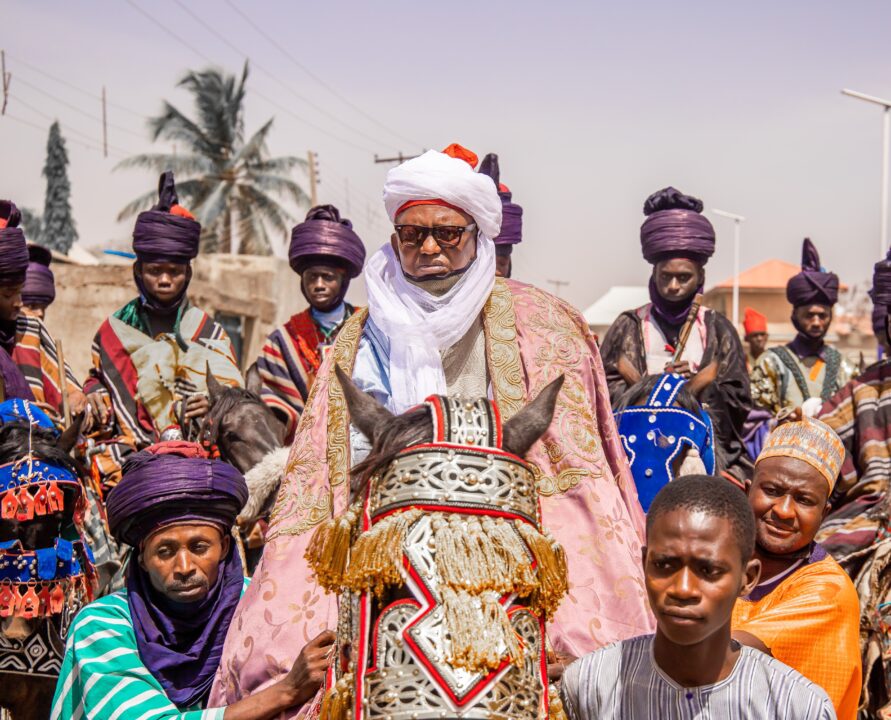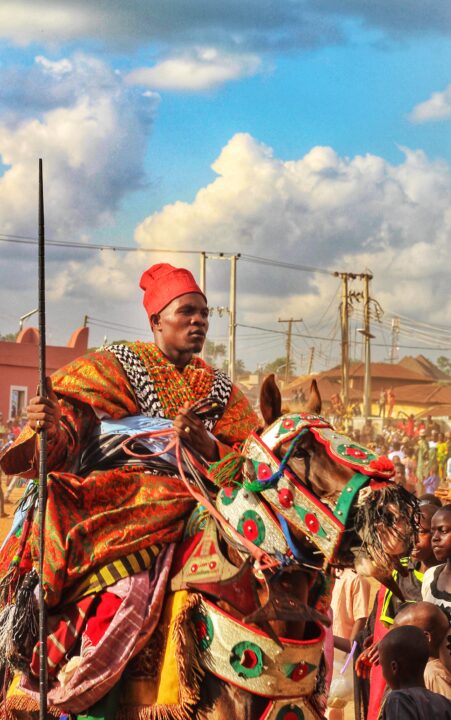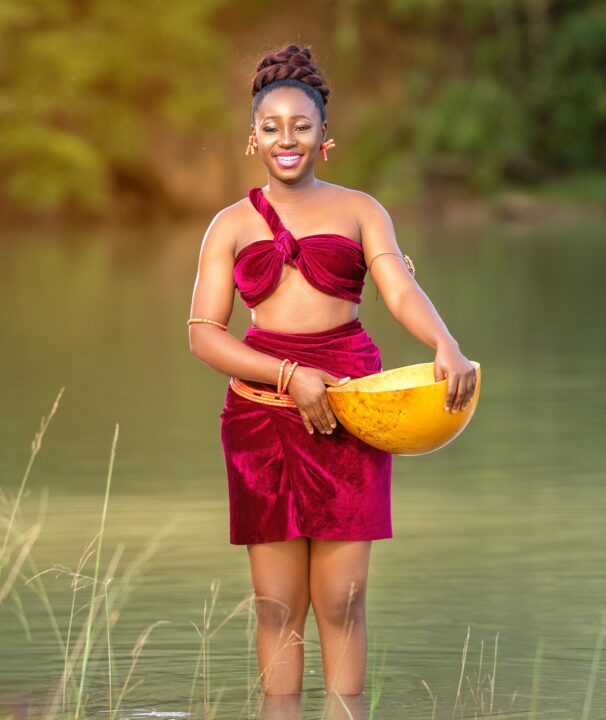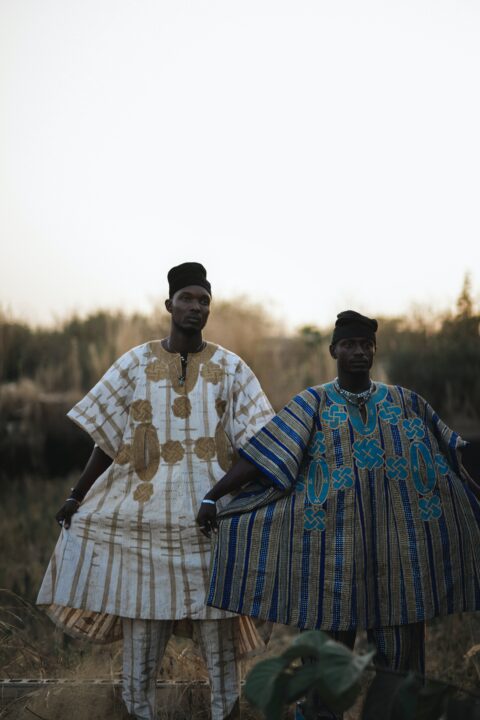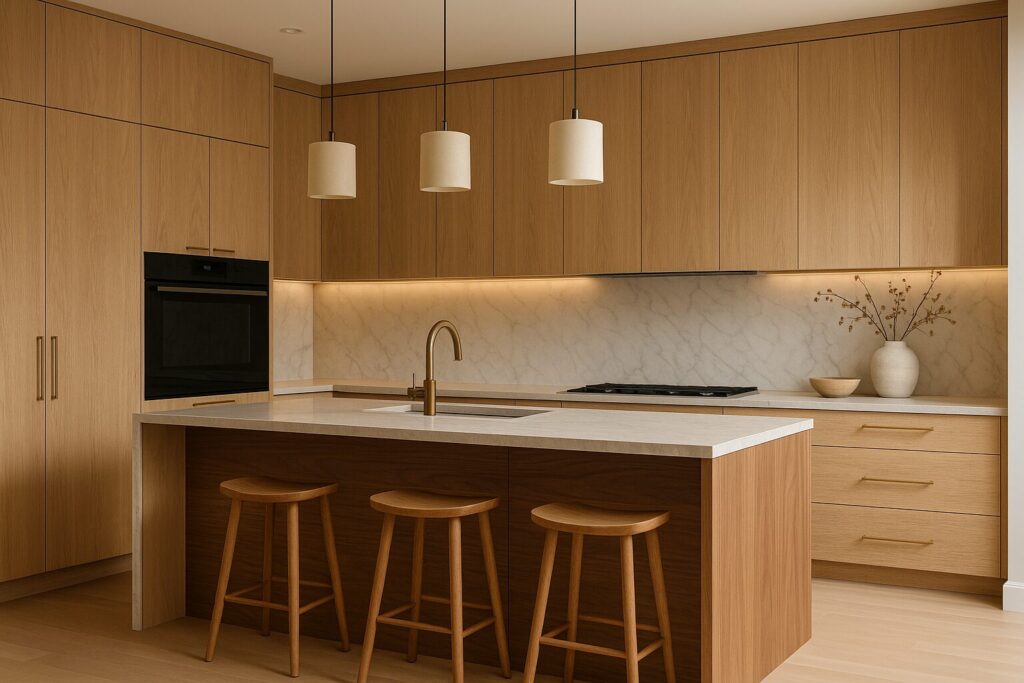Nigeria is a country in West Africa and also Africa’s most populous country, with numerous tribes and ethnic groups, many of which have their own distinct cultures and wear their own styles of clothing. Nigeria is a very ethnically diverse country, with over two hundred and fifty ethnic groups.
The largest ethnic groups in Nigeria are the Yoruba, Hausa and Igbo. These ethnic groups consist of several other smaller tribes, counting up to hundreds in the six geopolitical zones. As a result, it is pretty difficult to showcase the numerous traditional clothing in Nigeria, so we are going to focus on the major tribes in the northern and southern regions of Nigeria.
Due to the influence of the British, who were once the colonial masters of Nigeria before their independence in 1960, many areas of the country, especially the southern men and women, prefer to wear western attire.
Still, traditional attire is worn on a daily basis in many areas of Nigeria because there was no law forbidding anyone from putting on their traditional clothing except for the influence of Christianity and Islam, which deemed most of Nigerian clothing immodest. However, Nigerians were able to modify their dressing to suit their religion without giving up on their cultural styles.
Nigerian people wear colorful clothes that are usually made with natural materials. Traditional clothes in Nigeria are worn on important occasions such as traditional weddings, cultural events and parades and religious occasions. These traditional clothing vary by region in the country.
Therefore, the information in this article concentrates on the traditional clothes of men and women in each of the major tribes of Nigeria.
Top 10 Nigerian Traditional Clothing
1. Wrapper
The wrapper or lappa is a colorful garment worn mostly in West Africa by both men and women. In Nigeria, tying wrappers are typical of most tribes and are worn mostly by women.
There are different versions of wrappers, which can vary from simple draped clothing to fully tailored ensembles. The style of the wrapper depends on the fabric used to create or design it.
- Zani is a wrapper worn by Hausa women made with clothes such as atampa or ankara. This wrapper is accompanied by a matching blouse, a head tie called kallabi, and a shawl called gyale.
- Iro is a wrapper worn in Yorubaland. The full wrapper ensemble consists of three pieces, a blouse called bubba, iro, and a headscarf called gele and ipele, which is a shawl usually hung on the shoulders.
- Igbo women tie two wrappers with an embroidered puff sleeve shirt and a headscarf. Women from different Igbo tribes also wear white wrappers around their shoulders.
- Mudukare is a sleeveless crop top and wrapper worn by Fulani women.
2. Trousers
Yoruba men wear different kinds of native trousers, like sooro, streamlined trousers, kembe, 3-quarter baggy pants, or sokoto. Sokotos are trousers that are loose-fitting with a drawstring used to hold them up.
Igbo men wear plain trousers with the Isiagu.
Hausa men’s trousers are baggy at the top and center but tight around the legs and often worn with the baban riga.
3. Buba
A buba is a loose-fitting blouse or shirt with long sleeves that falls just below the waist. It has a neckline that is either V-shaped or round and is worn by both men and women. For women, the buba is worn with the iro (wrapper) and gele (head tie). For men, it is worn with sokoto (trousers), fila (hat), and traditional beaded jewelry.
It can be made of different fabrics like lace, brocade, cotton, and silk.
4. Agbada
Agbada is an oversized attire and loose robe similar to the baban riga of the Hausas, which the men wear like a jacket over lace-based clothes and a matching pair of trousers called sokoto.
5. Baban Riga
Baban Riga is a flowing gown worn by Hausa men on top of a kaftan. Babban riga is also known as agbada in the Yoruba tribe. They are usually wide, with openings at the left and right that allow for ventilation. The main difference between the baban riga of the Hausas and the agbada of the Yoruba is that it features elaborate embroidery designs around the neck and chest area.
The men’s baban riga is worn on special religious or ceremonial occasions and festivals such as weddings, and is worn mostly by leaders depending on their location and occupation and mostly their religion.
6. Kaftan
A kaftan is a simple long tunic with embroidery designs around the neck and chest. It can be worn inside the baban riga or as a robe with trousers underneath.
7. Isiagu
The Isiagu is a pullover silky shirt with a pattern on it, usually gold or red, and has lion heads printed on it. Igbo men mostly wear Isiagu; it looks like another popular Nigerian clothing called Danshiki. It is typically worn with plain trousers and the customary.
8. Danshiki
Danshiki is one of the traditional clothing in Nigeria. It is a brightly colored baggy shirt, mostly worn by Yoruba and Hausa men. It is an inner garment that can be worn with the baban riga.
9. Caps and hats
- The turban is worn by men in northern Nigeria. It usually covers a part of their face, leaving their eyes.
- Fila is a traditional male Yoruba hat, usually worn with an agbada. They love adding various accessories to their agbada outfit, like necklaces.
- Noppire: Noppire is a conical hat worn by the Fulanis.
- Hula is a colorful and heavily embroidered cap worn by Hausa men, unlike the more simple ones of the Yoruba, known as filas.
- Red caps or leopard print caps made from wool are worn by Igbo men and men in other Southern tribes. Traditionally, it is given to a man with a chieftaincy title and is usually paired with the Isiagu
10. Nza or horsetail
Nza or horsetail is a popular fashion accessory for both men and women held on the hands mostly used in Igbo ceremonies.
Differences in Nigerian traditional clothing
Due to the influence of the British who were once the colonial masters of Nigeria before their independence in 1960, many areas of the country, especially the southern men and women prefer to wear western attire.
Still, traditional attire is worn on a daily basis in many areas of Nigeria because there was no law forbidding anyone from putting on their traditional clothing except for the influence of Christianity and Islam, which deemed most of Nigerian clothing immodest. However, Nigerians were able to modify their dressing to suit their religion without giving up on their cultural styles.
This can be seen in the various traditional clothing of the northern and southern parts of Nigeria.
Traditional Dressing in Northern Nigeria
-

fatima yusuf, pexels, 13740603.jpg
The major tribes in Northern Nigeria include the Hausa, the Fulani and the Kanuri. Northern Nigerian fashion consists of a lot of layering and is really popular for its elaborate styles.
Traditional Clothing of the Hausa
The Hausa tribe is not just one of the three prominent ethnic groups in Nigeria but is also considered one of the largest tribes in West Africa. Hausas were famous for their cloth weaving and dyeing, leather sandals, cotton goods, leatherworking and export of such goods throughout the Middle Ages.
Hausa traditional clothing is unique, which makes it easy to identify a Hausa man or woman anywhere you may find him or her. For women, tying wrappers is typical of most tribes in Nigeria. The Hausa women are known by their wrappers called zani, made with a colorful cloth known as atampa or ankara. This wrapper is accompanied by a matching blouse, a head tie called a kallabi and a shawl called a gyale.
Also, an ankara blouse and skirt or dress are usually accompanied by a complementing veil. The kind of occasion a Hausa woman attends plays a great role in the quality and intricacy of her material. For instance, big occasions require heavier and more detailed fabrics, while simple materials in the form of long, loose gowns known as abayas are usually for casual settings, although they can be dressy too. Hausa women wear a lot of flashy jewelry and lalle, or henna, usually on the hands.
Hausa men’s traditional attire is usually a flowing gown known as a babban riga worn on top of a kaftan. Babban riga is also known as agbada in the Yoruba tribe. They are usually wide, with openings at the left and right that allow for ventilation. The main difference between the babban riga of the Hausas and the agbada of the Yoruba is that it features elaborate embroidery designs around the neck and chest area. Then the trousers for babban riga are baggy at the top and center, but tight around the legs.
The men often wear a head turban, which usually covers a part of their face, leaving their eyes open. They also wear caps that are heavily embroidered, unlike the simpler ones of the Yoruba, known as filas. The men’s babban riga is worn on special religious or ceremonial occasions and festivals, such as weddings, and is worn mostly by leaders depending on their location and occupation and mostly their religion.
Men also wear a simple long tunic with embroidery designs around the neck and chest, trousers and colorful caps known as hulas. The hula also well embroidered and beautiful.
Traditional Clothing of the Fulani
The Fulanis are a tribe with a diverse and rich culture, tradition, and history across Africa. They are mostly known for their nomadic lifestyle and physical attractiveness, which is distinct from the other tribes.
In Nigeria, the Fulani are closely classified with the Hausas because they have exchanged cultures. Their men and women mostly wear white cotton or sometimes leather fabric. With well-detailed symbols on the outfit mostly in blue, red, and green thread embroidery. They are also famous for their tattoos, body art and tribal marks.
Fulani women are also fond of using henna (a dye prepared from a plant used for body decoration). Henna is used to decorate their arms, feet, and legs. Fulani women wear the mudukare (a sleeveless crop top worn over a wrapper). They wear beautiful amulets known as lohol that serve as both beautification and protection.
The Fulani women love their jewelry. They love to adorn themselves with different jewelry pieces. From beads around their waist and bracelets on their hands to jewelry on their heads, noses, and earrings. The traditional ethnic Fulani earrings are gold, twisted earrings called dibi, gold necklaces called caaka and thick metal bracelets with engravings on them.
Fulani men’s traditional attire is not as elaborate as the women’s. Their clothing simply consists of a long sleeveless shirt with shorts that are usually three-quarters, and a conical hat called a noppire. Their shirts usually have beautiful patterned geometric designs in multiple colors.
Traditional Clothing of the Kanuri
The Kanuri are one of the most conservative ethnic groups in Nigeria, occupying the northeastern part of the country.
Their dressing is a reflection of their identity and history. They mostly adorn themselves with bright colors and bold patterns, often inspired by nature, such as animals, plants and shapes. Their attire also reflects their social status, age and marital status. For instance, married women wear more elaborate clothing than unmarried ones.
Their men are known to wear long, roomy garments with caps. They have a loose-fitting, long-sleeved tunic made from colorfully patterned fabric called boubou or jalabiya. The boubou is worn with loose-fitting trousers and a woven straw or fabric cap called a fula or hula.
The women’s traditional attire is usually a colorful, flowing gown adorned with intricate beads and embroidery known as dandare or muumuu. The gown is worn over a wrap skirt called shiwa with the same design as the gown. A headscarf known as a gele usually completes the outfit.
Traditional Clothing in Southern Nigeria
-

kureng workx, pexels, 7637619.jpg
The southern part of Nigeria is predominantly Igbo in the East and Yoruba in the West. Then there are other major tribes in the South-central part of Nigeria, including the Edo, Ijaw, Ibibio, Efik and Urhobo tribes.
Traditional Clothing of the Igbos
The Igbos are people mostly found in the southeastern part of Nigeria. They have a unique look that cannot be mistaken for any part of Nigeria.
The ancient Igbo traditional attire consisted of little clothing, as the purpose of clothing originally was simply to cover the private body parts. Although the elders were fully clothed, children were usually nude from birth until their adolescence, but sometimes ornaments such as beads were worn around the waist.
However, little or none of the Igbo’s main traditional clothing is seen today because the European colonization of the country has heavily influenced the Igbo attire. Clothing in Igbo culture signifies social status; for example, the attire of the royal household, titled holders and chiefs is different from that of the untitled men.
Nowadays, Igbo men mostly wear Isiagu, a pullover shirt made with fabric that has lion heads printed on it. It looks like another popular Nigerian clothing style called danshiki. Traditionally, it is given to a man with a chieftaincy title and is usually paired with a red or leopard print cap made from wool.
Women wear form-fitting clothes in either isiagu or ankara that accentuate their figures in countless styles. Coral beads in the form of bracelets, earrings, necklaces, waist beads and anklets are the statement jewelry of the Igbos. Women also wear statement headgears or braids adorned with beads.
A popular fashion accessory for both men and women are called the nza, or horsetail, held on the hands and mostly used in ceremonies.
Traditional Clothing of the Yorubas
-

ottun abdulmalik, pexels, 7122397.jpg
The Yorubas mostly occupy the southwestern part of Nigeria and fashion from this part of the country is always evolving and finding new ways to use its styles. The Yoruba traditional clothing is very detailed and intricate, with much emphasis on matching sets and complementing pieces.
The Yorubas are well-known for clothes like agbada, gele, iro and buba and fabrics like aso oke and adire. Aso oke is a hand-woven cloth, while the adire is made by tie and dye! The Yoruba traditional attire is gender and social-status-sensitive. They believe that the type of attire they put on depicts their social status and personality.
The men wear kinds of native trousers like sooro (lined pants) and kembe a 3-quarter baggy pants or sokoto. They have native shirts called agbada. Agbada is an oversized attire and loose robe similar to the babban riga of the Hausas, which the men wear like a jacket over lace-based clothes and a matching pair of trousers. Yoruba men also wear different caps like fìlà, gobi, ribi, alagbaa, onide, labankada, and tinko. They love adding various accessories to their agbada outfit, like necklaces.
The women wear different types of dresses; the most commonly worn are the iro (wrapper) and bùbá (a blouse–like loose top). Women also have matching gele (head gear) that must be worn with the iro and buba. Women’s dressing is considered incomplete without gele. They also have iborun (a shawl) and ipele (long pieces of fabric that usually hang on the left shoulder and stretch beyond the waist). At times, it is tied around their waists over the original one-piece wrapper.
Traditional Clothing of the Edos
The Edo people are mostly found in South Southern Nigeria. They are residents of Edo State, and they can also be found across the Rivers, Ondo, and Delta states in Nigeria. They are an elegant and colorful community. Edo people love beads, and they believe that they symbolize freedom and royalty. Some of their accessories include raffia work, anklets, bangles, and beads.
The Edo men love wearing their suits and traditional gowns with two kinds of coral beads (ekan and ivie). Traditionally, men wore a white shirt or t-shirt with multi-colored striped fabric.
The Edo women tie beautiful wrappers made from a variety of fabrics, including velvet, lace and george. Their wrapper is worn around the waist and covered with a blouse called a fofo. The fofo was made up of two parts: an upper part called ore and a lower part called obi. They also wear a beaded cape or blouse called the ewu-ivie.
Edo women adorn their necks with coral beads known as ivie-uru and wear bracelets called ivie-obo on their hands with beaded earrings. Their handbag is made out of coral beads as well as the ekpa-ivie. The scarf is called okolo and it is made of cotton fabric that has been dyed indigo.
